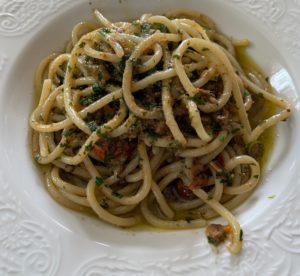
A plate of spaghetti aglio e oglio (garlic and olive oil)
This is the simplest recipe for a great pasta, and we Romans often have this pasta as a midnight snack after coming home from dancing. It’s also known as “pasta del cornuto,” because traditionally it was the wife who would cook the pasta for the husband who was working many hours to prepare delicious dishes. But if the wife had an affair and thus had no time to cook before the husband came home, she could rush home to cook and prepare something in five minutes. So, when you are in a hurry, this is the pasta to prepare.
The most basic version of the recipe involves only a few ingredients: spaghetti, olive oil, garlic, and fresh chopped parsley. A variation on the recipe includes adding anchovies and a few pear tomatoes into the mix.
Ingredients for 4 people
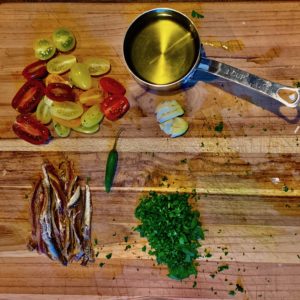
Ingredients for spaghetti aglio e oglio
- 300 grams of spaghetti
- 1 cup olive oil of the best quality
- 2 smashed cloves of garlic
- ½ cup chopped parsley
- 4 Calabrian, hot peppers, minced (or other peppers)
- For my variation on the recipe:
- 24-32 filets of anchovies, minced (depends how big they are, if you look at the photo on the right, those are big anchovies, so I used 12 anchovies = 24 filets.
- 12 “pear” or cherry tomatoes, yellow and red, cut in half
Preparation
- In a large pot of salted, boiling water, add the spaghetti. You will cook it for about 1 – 2 minutes less than the cook time for the pasta you’ve selected.
- In the meantime, in a small saucepan, heat the olive oil and add the garlic cloves. As soon as the garlic is golden, remove it with a fork or a slotted spoon.
- Bring the heat to high and add the minced Calabrian peppers, 2 spoons of minced parsley, and the minced anchovies.
- Wait for a minute for the anchovies to melt, and then turn the heat to medium and add the pear tomatoes.
- Cook on medium heat until the pear tomatoes become soft, about 5 minutes.
- In the meantime cook the pasta until about 2 minutes before the recommended cooking time. Drain the pasta and then pour the pasta back into the same pot (which should still be hot), and then put back on the stove on a low-to-medium heat. Add the aglio e oglio sauce and mix well with the spaghetti, allowing it to cook together 2 more minutes stirring constantly. Turn fire off.
- Just before serving, add 1 more TB of minced fresh parsley, mix well and and plate the pasta.
- Please do not add anything else – especially no cheese!!!.
- Buon appetito!
Italiano: Spaghetti aglio e olio
Ingredienti per 2 – 4 persone, dipende dall’appetito.
- 300 grammi di spaghetti
- 225 ml di olio d’oliva della migliore qualità (1 cup)
- 2 spicchi d’aglio schiacciati
- Un pugno di prezzemolo tritato
- 4 peperoncini calabresi (più profumati) o altro tipo, tritato
- Per la mia variazione sulla ricetta:
- Circa 12-16 alici de-lisciate e tritate (il numero dipende da quanto sono grandi)
- 12 pomodorini a “pera” gialli e rossi, tagliati di lungo a metà
Preparazione
- Soffriggere nell’olio 2 spicchi d’aglio schiacciati, rimuoverli appena prendono colore aggiungere peperoncini piccanti tritati, 1 pugno di prezzemolo tritato e alici.
- Dopo un minute (minuto) aggiungere 12 pomodorini piccolo (piccoli), quelli a pera, oppure 8 San Marzano, tagliati a metà.
- Abbassare il fuoco a medio, appena diventano soffici, circa 5 minuti spegnere il fuoco.
- Quando la pasta è pronta mischiare bene in padella 2 minuti a fuoco medio, poi per bellezza spolverare con prezzemolo triato (tritato) fresco e servire.
- Buon appetito!

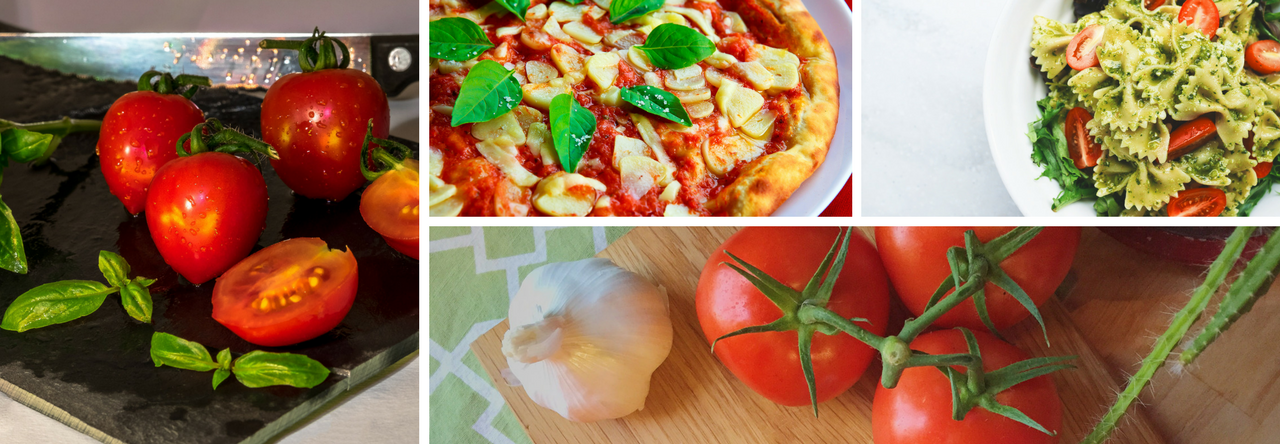
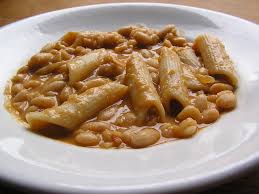
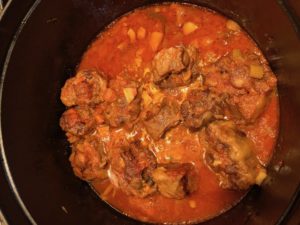
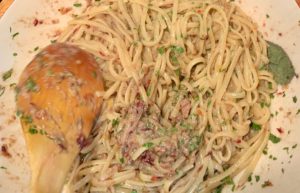 This pasta reminds me of summertime, with its lovely scent of orange and mint. It’s a recipe that can only be made in small portions, so don’t try to increase the measures in this recipe. It’s my friend
This pasta reminds me of summertime, with its lovely scent of orange and mint. It’s a recipe that can only be made in small portions, so don’t try to increase the measures in this recipe. It’s my friend 